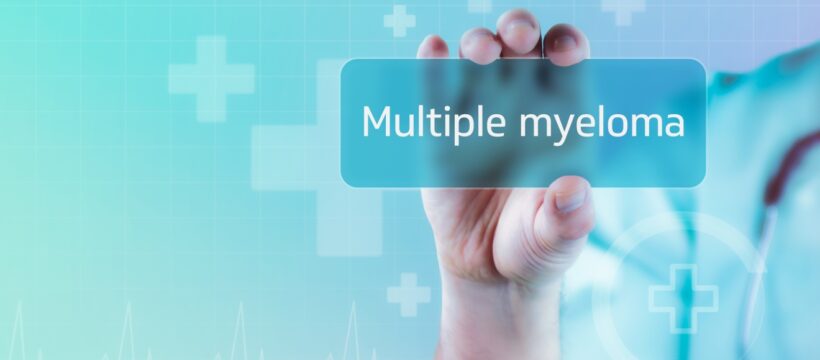Research at Karl Landsteiner University of Health Sciences demonstrates synergistic effect of inhibiting two regulatory proteins in multiple myeloma.
Krems (Austria), 16. October 2024: The simultaneous inhibition of the transcription factors Myc and JunB could represent a pioneering therapeutic option for the treatment of multiple myeloma (MM), the second most common type of blood cancer. This is the outstanding result of a recent study conducted by a team of the Karl Landsteiner University of Health Sciences (KL Krems) together with Austrian and American colleagues. The study was the first to show that the two regulatory proteins have independent effects in MM cells. The simultaneous inhibition of both proteins thus resulted in a synergistic anti-tumor effect.
Multiple myeloma (MM) is the second most common hematopoietic malignancy, still considered incurable despite unprecedented therapeutic advances over the last two decades. Novel therapies are therefore needed. Since several years the team of Prof. Mag. DDr. Klaus Podar, Head of the Division of Molecular Oncology and Hematology, Division of Internal Medicine 2 at University Hospital Krems (one of the education- and research sites of KL Krems) focuses its research on the role of tumor-associated transcription factors (TFs), proteins that bind to specific DNA sequences and act as regulators, and the derived development of TF inhibitors. However, TF inhibitors were thought to be “undruggable” until most recently. The team’s previous studies have demonstrated a pathophysiologic role of the TF JunB in MM, tumor cell proliferation and drug resistance in particular. Moreover, they established that JunB also increases the proliferation of tumor-promoting blood vessels in the bone marrow.
Separate Pathways
The present study shows for the first time that JUNB and MYC, another crucial TF in MM, orchestrate distinct transcriptional programs. In addition, data emphasize the opportunity to employ JUNB and MYC dual-targeting treatment strategies in MM as another exciting approach to further improve patient outcome. In detail, the team demonstrated that the expression of the respective target genes of the two TFs is controlled independently of each other in MM cells. “This was our first indication that JunB and Myc could actually control largely independent signaling pathways in MM cells,” explains Prof. Podar.
Caught in The Pincers
“Of course, we were immediately interested to see whether simultaneous inhibition of both transcription factors have a mutually reinforcing – i.e., synergistic – effect against MM cells,“ says Prof. Podar. The team then carried out several experiments in which the TFs were inhibited individually or together using therapeutic agents or genetic methods. “And indeed, such a pincer attack on MM cells led to a greater increase in MM cell death in both cell and animal models compared to single inhibition,” explains Prof. Podar. “Our efforts are now focusing on the identification and development of new substances that can be successfully used in our patients.”
The work, which was recently published in the Blood Cancer Journal, demonstrates a potential new therapeutic option for the treatment of MM and is thus in line with the research focus of KL Krems. This focus is on preclinical research with high relevance for patients. The work was carried out under the coordination of Prof Podar with colleagues from Harvard Medical School (USA), the Medical University of Vienna, the University of Veterinary Medicine Vienna and the University of Science and Technology in Wuhan (China).
Original publication: Dual therapeutic targeting of MYC and JUNB transcriptional programs for enhanced anti-myeloma activity. J. Lind, O. Aksoy, M. Prchal-Murphy, F. Fan, M. Fulciniti, D. Stoiber, L. Bakiri, E. F. Wagner, E. Zwickl-Traxler, M. Sattler, K. Kollmann, S. Vallet and K. Podar. Blood Cancer Journal (2024)14:138. https://kris.kl.ac.at/de/publications/dual-therapeutic-targeting-of-myc-and-junb-transcriptional-progra
Karl Landsteiner University of Health Sciences (10/2024)
The Karl Landsteiner University of Health Sciences (KL Krems) is an educational and research institution on the Campus Krems and recognised throughout Europe. KL Krems offers modern, demand-oriented education and continuing education in medicine and psychology as well as a PhD programme in Mental Health and Neuroscience. The flexible educational programme is tailored to the needs of students, the requirements of the labour market and the challenges of science. The three university hospitals in Krems, St. Pölten and Tulln and the MedAustron Ion Therapy and Research Centre in Wiener Neustadt guarantee clinical teaching and research of the highest quality. In its research, KL Krems focuses on interdisciplinary fields with high relevance to health policy – including biomechanics, molecular oncology, mental health and neuroscience as well as the topic of water quality and the associated health aspects. KL Krems was founded in 2013 and accredited by the Austrian Agency for Quality Assurance and Accreditation (AQ Austria). https://www.kl.ac.at/en
Scientific Contact
Prof. Mag. DDr. Klaus Podar
Division of Internal Medicine 2
University Hospital Krems
Karl Landsteiner University of Health Sciences
Mitterweg 10
3500 Krems / Austria
T +43 2732 9004 12355
E klaus.podar@krems.lknoe.at
Karl Landsteiner University of Health Sciences
Eva-Maria Gruber
Communications, PR & Marketing
Dr.-Karl-Dorrek-Straße 30
3500 Krems / Austria
T +43 2732 72090 231
M +43 664 5056211
Copy Editing & Distribution
PR&D – Public Relations for Research & Education
Dr. Barbara Bauder-Jelitto
Kollersteig 68
3400 Klosterneuburg / Austria
M +43 664 1576 350
L https://www.linkedin.com/company/prd-public-relations-für-forschung-bildung

